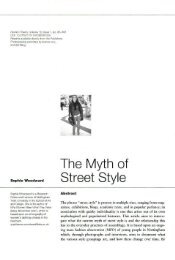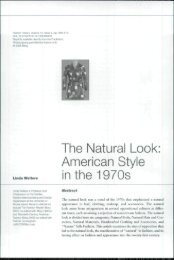Spinning the Ephemeral PDF - SMU Fashion Media
Spinning the Ephemeral PDF - SMU Fashion Media
Spinning the Ephemeral PDF - SMU Fashion Media
Create successful ePaper yourself
Turn your PDF publications into a flip-book with our unique Google optimized e-Paper software.
288 Fiona Anderson<br />
Figure 3<br />
Party at Drumochter Shooting<br />
Lodge. Scotland. 1882.<br />
Courtesy of <strong>the</strong> Trustees of<br />
National Museums of Scotland,<br />
a variety of urban contexts, and that <strong>the</strong> image we have today of tweeds<br />
as cloths that were primarily worn in <strong>the</strong> country and not in <strong>the</strong> town,<br />
up until <strong>the</strong> early twentieth century is erroneous. For example, an advert<br />
of January 2 1869 in <strong>the</strong> Tailor and Cutter trade journal, for <strong>the</strong> Londonbased<br />
woolen merchants James Platt and Co., promotes tweeds "made<br />
expressly for us by Scotch manufacturers" that "For riding trousers, ot<br />
as a gentlemanly trouser for ordinary wear, or for suits, <strong>the</strong>y surpass any<br />
o<strong>the</strong>r goods made." The Tailor and Cutter of October 2 of <strong>the</strong> same year,<br />
in an article on "Materials for Winter 1869-70,'" fur<strong>the</strong>r stated that "for<br />
Suits, Check and Mixed Tweeds have been tnuch worn this summer and<br />
we think <strong>the</strong>re will be <strong>the</strong> same tendency through <strong>the</strong> autumn."<br />
A previous study carried out on tbe sales records of <strong>the</strong> leading Savile<br />
Row tailor Fienry Poole and Co. suggests that in 1900, just over half of<br />
<strong>the</strong> orders sampled for some form of lounge suit or lounge jacket consisted<br />
of tweed. At that elite level of <strong>the</strong> international menswear market, tweed<br />
was primarily worn as informal morning wear in town, as pea coats,<br />
capes, and overcoats, and also as country or sporting wear (Anderson<br />
1998; Breward 1999: 49-61}. For example in Figure 4. Brooke Boothby,<br />
who held <strong>the</strong> typically upper-middle-class position of Second Secretary<br />
at <strong>the</strong> British Embassy in Vienna in 1889 may be seen wearing a tweed<br />
suit as urban, informal morning wear.<br />
It is likely that tweed would have been equally if not more prominent<br />
within <strong>the</strong> less occasion-specific wardrobes of middle-middle-class and<br />
lower-middle-class consumers of <strong>the</strong> closing decades of <strong>the</strong> nineteenth<br />
century (Figure 5). This is owing to <strong>the</strong> increasing dominance of <strong>the</strong> lounge<br />
suit as respectable work attire, <strong>the</strong> hard-wearing properties of <strong>the</strong> cloth




